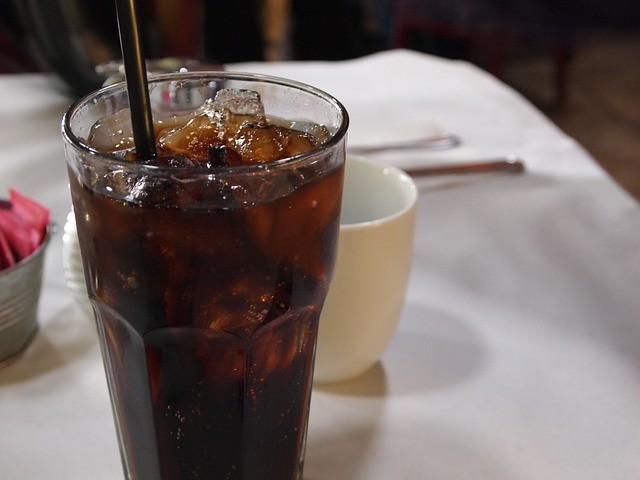Non-alcoholic drinks that can harm our liver without us knowing. Check out the article we found over at Mercola.com.
Non-alcoholic fatty liver disease (NAFLD) is defined as an excessive accumulation of fats, often accompanied by elevated enzyme levels, in your liver in the absence of significant alcohol consumption.
While it’s normal for your liver to contain some fat, accumulations of more than 5 percent to 10 percent of your liver’s weight are problematic.
Alcohol consumption is a leading cause of fatty liver, but in the case of NAFLD, it occurs in people who are overweight or obese, have high cholesterol, or high triglycerides, and who consume little or no alcohol.
Some people develop NAFLD even without any known risk factors, and this condition affects up to 25 percent of Americans.
NAFLD often has no symptoms, although it may cause fatigue, jaundice, swelling in the legs and abdomen, mental confusion, and more. If left untreated, it can cause your liver to swell, called non-alcoholic steatohepatitis (NASH), or even contribute to liver cancer or liver failure.
One of the most important aspects to remember if you’re dealing with NAFLD is this: eating right and exercising can often prevent this condition and may even reverse it in its early stages.
Excess Fructose Is a Leading Cause of Non-Alcoholic Fatty Liver Disease
In your quest for a healthier diet, the first ingredient to eliminate would be fructose – the sugar found in everything from high-fructose corn syrup (HFCS)and fruit juice to agave syrup and honey. It’s harmful when consumed in excess – which is exactly what many (if not most) Americans do.
Fructose is, in many ways, very similar to alcohol in the damage that it can do to your body… and your liver. Unlike glucose, which can be used by virtually every cell in your body, fructose can only be metabolized by your liver, because your liver is the only organ that has the transporter for it.
Since all fructose gets shuttled to your liver, and, if you eat a typical Western-style diet, you consume high amounts of it, fructose ends up taxing and damaging your liver in the same way alcohol and other toxins do. In fact, fructose is virtually identical to alcohol with regard to the metabolic havoc it wreaks.
According to Dr. Robert Lustig, a neuroendocrinologist in the Division of Endocrinology at the University of California, fructose is a “chronic, dose-dependent liver toxin.” And just like alcohol, fructose is metabolized directly intofat – not cellular energy, like glucose.
His findings were published in the Journal of the Academy of Nutrition and Dietetics, where Dr. Lustig explained the three similarities between fructose and its fermentation byproduct, ethanol (alcohol):
- Your liver’s metabolism of fructose is similar to alcohol, as they both serve as substrates for converting dietary carbohydrate into fat, which promotes insulin resistance, dyslipidemia (abnormal fat levels in the bloodstream), and fatty liver
- Fructose undergoes the Maillard reaction with proteins, leading to the formation of superoxide free radicals that can result in liver inflammation similar to acetaldehyde, an intermediary metabolite of ethanol
- By “stimulating the ‘hedonic pathway’ of the brain both directly and indirectly,” Dr. Lustig noted, “fructose creates habituation, and possibly dependence; also paralleling ethanol.”
How Excess Fructose Directly Contributes to NAFLD
Writing in the journal Hepatobiliary Surgery and Nutrition, researchers noted that the rapid rise in NAFLD prevalence supports the role of environmental factors.
The overconsumption of high-fructose corn syrup (HFCS) in soda is associated with NAFLD, while the study also concluded “ingested carbohydrates are… more likely to directly contribute to NAFLD than dietary fat intake.”
The fat-forming and pro-inflammatory effects of fructose appear to be due to transient ATP (the chemical storage form of energy) depletion, according to the study. This, in turn, leads to uric acid formation.
Fructose increases uric acid through a complex process that causes cells to burn up their ATP rapidly, leading to “cell shock” and increased cell death. After eating excessive amounts of fructose, cells become starved of energy and enter a state of shock, just as if they have lost their blood supply.
Cells that are depleted of energy become inflamed and more susceptible to damage from oxidative stress. Fat cells actually become “sickly,” bloating up with excessive amounts of fat.
Massive cellular die-off leads to increased uric acid levels. Uric acid is a normal waste product found in your blood. It functions both as an antioxidant and as a pro-oxidant once inside your cells.
So, if your uric acid levels are too high, it tends to increase to harmful levels inside your cells as well, where it acts as a pro-oxidant. According to Dr. Richard Johnson, who conducted years of research on the role of fructose in obesity uric acid appears to take on a lead role in creating health problems when it reaches levels in your body of 5.5 mg per dl or higher.
At this level, uric acid is associated with an increased risk for developing high blood pressure, as well as diabetes, obesity, and kidney disease. The ideal range for uric acid lies between 3 to 5.5 mg per dl.
The connection between fructose consumption and increased uric acid is so reliable that a uric acid level taken from your blood can actually be used as a marker for fructose toxicity. I now recommend that a uric acid level be a routine part of your blood screening.
Exercise Is Also Important for Treating NAFLD
The current standard of treatment for NAFLD centers around dietary changes to promote weight loss, which is important, but research shows exercise is also incredibly important, regardless of whether or not you lose weight. In fact, just exercising for more than 150 minutes per week for three months, or increasing fitness levels, was enough for participants to show improvements in fatty liver disease.
Another study published in the European Journal of Gastroenterology and Hepatology in 2006 also found that three months’ worth of nutritional guidance, plus a pair of one-hour exercise sessions each week, helped obese teens improve fatty liver disease. Before the study, more than half of the patients had fatty liver disease on the right side of their organ and almost half had it on their left side. Afterward, fatty liver disease — on either side — fell sharply to 29 percent, and almost half of the young patients lost weight.
Next Article: Federal Government Blocks Herb That Could Make Your Liver Bulletproof
Read full article: Causes and Effects of Non-Alcoholic Fatty Liver Disease







Stephen Redd
May 26. 2016
Health Tip. Stay Healthy. 🙂
Alles Paletti
May 26. 2016
Stay healthy with health simplified! Famerdt.Kyaniviral.Com/triangle
Masako Cavallo
May 27. 2016
Yukino Cavallo
Lisa Brian Helton
Aug 07. 2016
Lovely…what else shall we add to the list of toxins to our body!